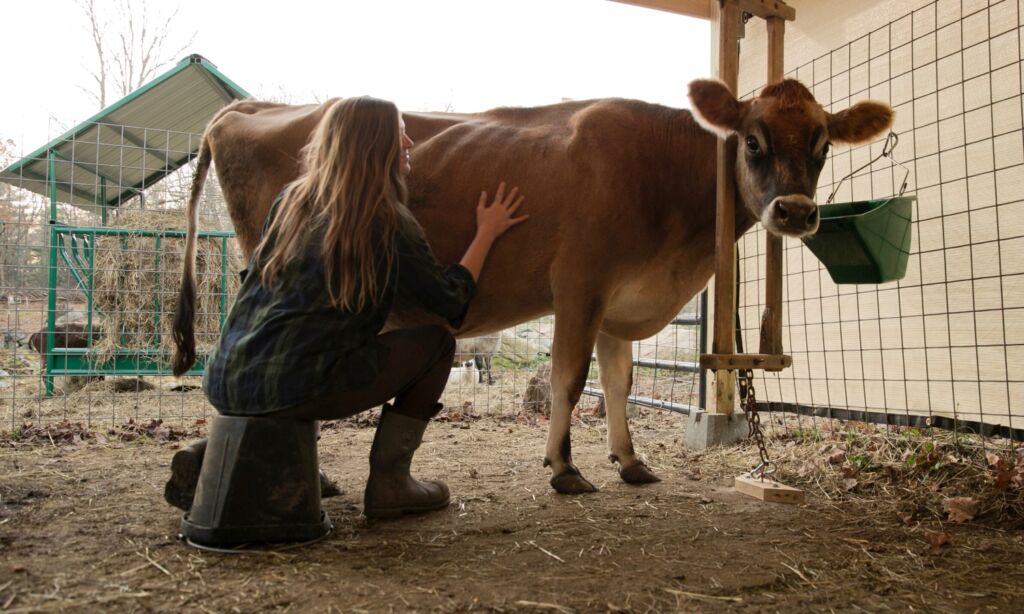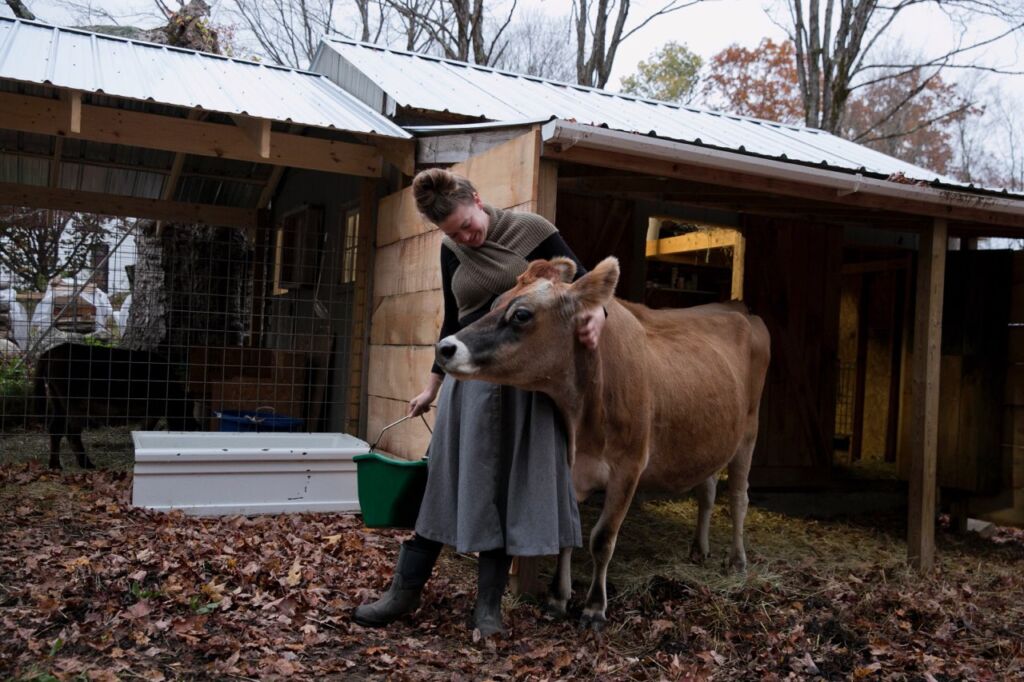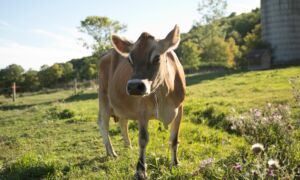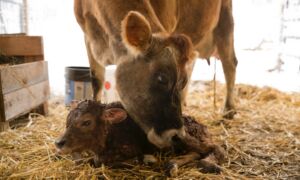Hypocalcemia also known commonly as “Milk Fever” (MF) is a metabolic disorder that affects newly freshened animals. It can commonly be seen in goats, sheep, and cows, and is particularly more prevalent (though not exclusive) in dairy breeds. Typically dairy animals that are high producing breeds and/or older cows are most at risk for developing MF. With that being said, there are many factors that can come into play. Some breeds being more prone than others, body condition during gestation/calving, and of course the biggie, nutrition. There is no guaranteed 100% way to prevent milk fever – hence this being my “prevention” plan. Emphasis on those quotations! However, there are many things that can be done to help reduce the chances. When I knew I was going to bring Lassie home, I immediately started working with my vet on a MF “prevention” plan. With some helpful suggestions from Zack at Orb Weaver Creamery as well. Like so many things when it comes to animals, proper nutrition reigns supreme, and is a critical component to reducing the chances of MF.

What is Milk Fever?
First things first, Milk Fever is a misnomer, as a fever doesn’t actually present when a cow/goat/sheep is affected by it. So let’s just get that straight right out of the chute. In its simplest definition, hypocalcemia is ” a deficiency of calcium in the bloodstream”. In a nutshell, what happens is leading up to calving when the cow is dry her body has a low demand for calcium production. This causes the parathyroid hormone that’s responsible for calcium mobilization to go into a somewhat dormant stage of sorts. Then, right around calving, her body has a sudden onset high demand for calcium for the calf and to produce colostrum. This demand is 8-10x more than what her blood requires, and is more than can be achieved through diet. When her body cannot meet the demand, she goes into homeostatic failure.
Calcium is vital to smooth muscle contractions, as well as proper rumen and cardiovascular function. In its clinical form, the cow can quickly lose control of muscle function. This makes her unable to stand and she goes down, ears go cold, rumen shuts down, abomasal can be displaced, coma occurs, and death can quickly follow. In its subclinical form, the symptoms are not as severe because the disparity between the body’s production and the requirements is not as large. However, it is equally important as statistically it is much more prevalent than clinical MF and is responsible for loss of milk production. The cow is also at a higher risk for infection such as mastitis or secondary metabolic disorders.
The Dry Period
A proper diet to prevent milk fever starts as far back as the dry period. Most will dry off their cows 2-3 months prior to their due date. This time of no milk production allows the cow to recover from lactation, while putting the nutrients and energy into her growing calf.
A mistake that can be made during this dry period is that cows are fed the same as if they were still in milk. This should not be the case. While lactating, cows are fed a high calcium diet to meet their bodies demand whether that be in the form of calcium-rich forages such as alfalfa and clover, a grain ration, and mineral supplementation. As I mentioned previously, while dry, a cows requirement for calcium drops significantly. By continuing to provide more calcium than needed via diet, the parathyroid that is responsible for calcium mobilization goes into a dormant stage. Then when the call for high calcium is put on the body at freshening, the parathyroid struggles to snap out of this latent stage to meet the demand.
The goal during the dry period is to reduce the calcium. So, if you’re feeding alfalfa pellets, stop. If you’re providing a mineral supplement that is high in calcium, stop. If you are feeding out legume rich grass hay and can possibly help it, stop. The key is to reduce calcium intake so that her body goes into a slight calcium deficient state. By being slightly calcium negative, her parathyroid doesn’t go into that dormant stage to begin with. Which means that when her body says “we need a lot of calcium, stat!” it’s already active and can more easily mobilize the calcium in her body and ramp up production.
At the suggestion of my vet, I am taking all of the measures I mentioned above. Low calcium mineral (1.25%), minimal legumes, no alfalfa. In addition, starting right around the 21 day mark prior to calving, I am feeding out a specific “pre fresh” grain ration. It is specifically formulated to provide the vitamins, yeast, and trace minerals her and her growing calf need, while specifically being designed with MF in mind. Dietary Cation-Anion Difference (DCAD) diets are also popular and something I heavily researched, but my vet suggested that for my single milk cow it was unnecessary and so we went the aforementioned route.

At Freshening
The goal is to provide the best prevention diet during the dry period to set her body up to naturally ward off MF on her own. However, things don’t always work out as planned. Depending on your location, maybe your cow is on pasture when she’s dry that is loaded with alfalfa and clover and you can’t avoid it. It happens. For me, Lassie is dry in late fall/early winter when I am starting to feed out hay, so I have a bit more control over what she eats by feeding out different cuts.
Maybe you have followed a low calcium diet to the letter, but just want that little extra added bit of insurance. That’s me! I am big on doing everything I can to prevent something (especially as serious as MF) from happening in the first place and if I can spend $20 for something that’s going to make all the difference, I’ll do it.
Bovikalc is a calcium bolus that I will administer immediately after calving, and then again twelve hours later. It has two different types of calcium: calcium chloride for immediate absorption and use, and calcium sulfate for slower absorption and sustained use. The administration of the bolus will provide the additional calcium her body needs at freshening if her body is struggling to mobilize calcium on its own to prevent the deficiency. It’s like a calcium insurance policy and is $20 very well spent.
Despite doing everything I possibly can to set Lassie up for success and to prevent milk fever, it still could very well happen. There are no guarantees! So, I will still be very diligent and observant of any early signs of MF and will make no hesitation to call the vet. Milk Fever is literally life and death and a cow can go from having cold ears and standing, to down and comatose in an hour. It is nothing to mess around or gamble with.
Like with anything else, there is more than one way to skin a cat. This is the route that I have chosen to go after much diligent research on my end and conversations with my vet. Some may use an oral paste after calving versus a bolus, fine. Some may feed a different diet, that’s fine too. People have different opinions on how things should be done, and I’m certainly not toting my way to be the best or only way, just merely sharing what I do and why. Here’s to a hopefully uneventful calving in just three short weeks!
Happy Calving,




Thank you for sharing. Helps a ton!
So helpful! I have a cow due in May so this sure came in handy!!
Wonderful!
Excellent post. Thank you for that information. Have you ever heard about how milking the cow out after calving can bring on milk fever? Around here, the old timer suggest just milking ten pulls from each teat, twice a day for the first four days, to relieve pressure, and then you can milk normally after that. My cow is six and that is what I tried, plus the lactation pellet. She did great, but I was still worried about milk fever until we passed the ten day mark
Yes! There are two different thought processes it seems. Some completely milk out to prevent mastitis from developing, but that creates an increased milk demand which can bring on MF. Some minimally milk out to prevent MF, but you need to have a very close eye on mastitis potentially developing. I am in the second camp. I would only milk out enough to relieve pressure and get some milk for the house the first couple of weeks. Enough I felt that I was keeping mastitis at bay, but not so much that I was triggering her to produce even more and bring on MF.
I can find bovikalc EVERYWHERE but I can’t find an applicator to save my life…do you use an applicator or something else?
This is where I got mine – both the boluses AND applicator!
Hey!! I love this very informative, I appreciate the knowledge! What would you recommend feeding threw her dry period? You mentioned you had control of types of feed. I have a couple ton of alpha hay for winter but sound like I might need to plan for other feeds for her before she calves in early March! Do you have any recommendations?
Dry period I feed the first cut hay and the transition grain ration in the weeks leading to calving. You want to avoid the high calcium feeds (like alfalfa and legumes) to keep her parathyroid hormone response to mobilize calcium from going dormant.